




Looking After Your Finds - Identification - Rocks and Minerals

The Rarest Minerals on Earth
Powered By Sispro1

Fibulae1
Copyright All Rights Reserved by Nigel G Wilcox E-Mail: ngwilcox100@gmail.com
Designed by Nigel G Wilcox
Complimentary Topics
The Paragon Of Metal Detecting
& Archaeology
& Archaeology
Pages
Rarest Minerals on Earth
Main Coin Menu
Roman Coins
Menu
Menu
Member NCMD
R&M Index
Blue Garnet
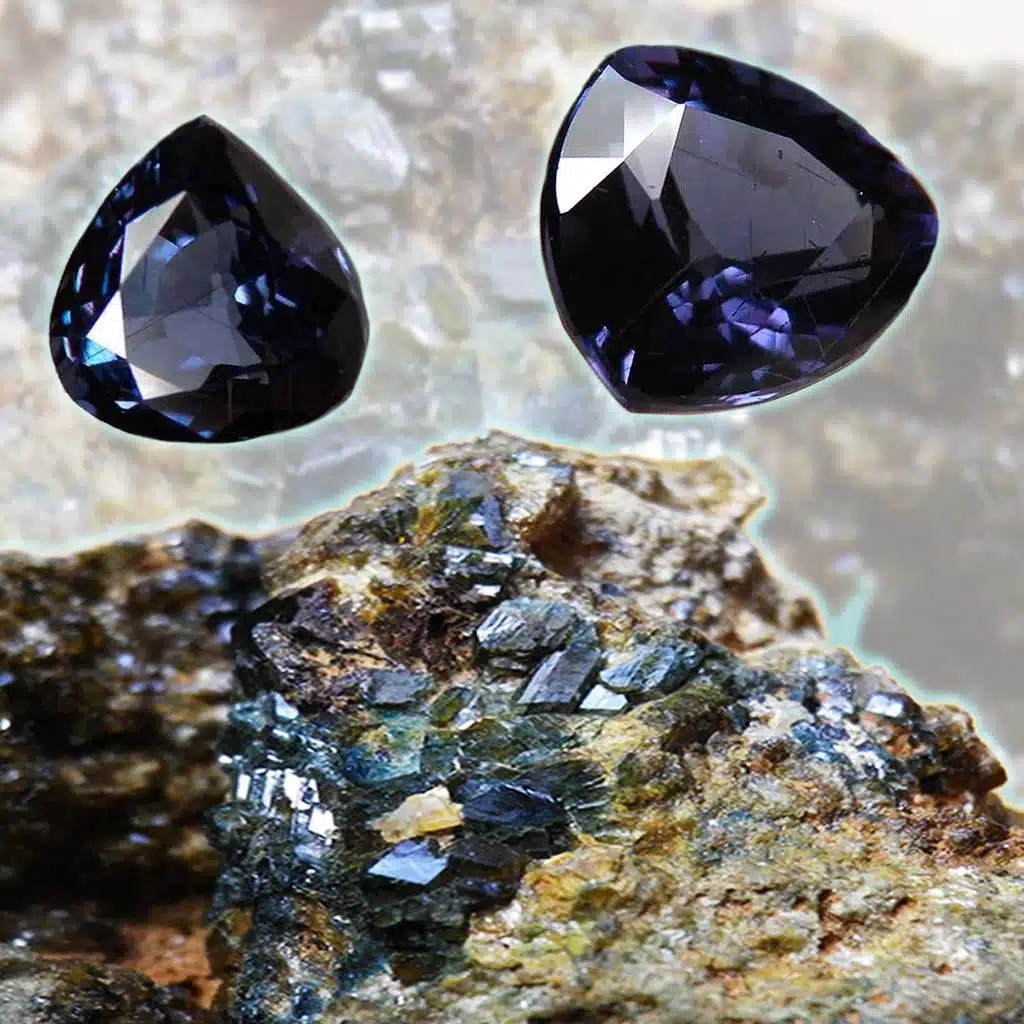
Blue garnet, a colour-changing gemstone, is one of the most astonishing gems in the world. Its colour changes from greenish-blue in daylight to purplish-red under incandescent light. This unique phenomenon is due to the presence of both vanadium and chromium in its composition. Blue garnets are exceptionally rare and prized by collectors.
Its exquisite hue and remarkable rarity make Blue Garnet a highly sought-after gem in the world of fine jewellery.
With its mesmerizing interplay of colours and exceptional brilliance, Blue Garnet stands as a symbol of luxury and elegance. Its scarcity and distinct colour-changing property contribute to its allure, captivating the hearts of collectors and gemstone connoisseurs. Blue Garnet remains a prized possession, adding a touch of exclusivity and sophistication.
The mineral garnet is commonly found in metamorphic and to a lesser extent, igneous rocks. Most natural garnets are compositionally zoned and contain inclusions. Its crystal lattice structure is stable at high pressures and temperatures and is thus found in green-schist facies metamorphic rocks including gneiss, hornblende schist, and mica schist. The composition that is stable at the pressure and temperature conditions of Earth's mantle is pyrope, which is often found in peridotites and kimberlites, as well as the serpentines that form from them. Garnets are unique in that they can record the pressures and temperatures of peak metamorphism and are used as geobarometers and geothermometers in the study of geothermobarometric which determines "P-T Paths", Pressure-Temperature Paths. Garnets are used as an index mineral in the delineation of isograds in metamorphic rocks. Compositional zoning and inclusions can mark the change from growth of the crystals at low temperatures to higher temperatures. Garnets that are not compositionally zoned more than likely experienced ultra high temperatures (above 700 C) that led to diffusion of major elements within the crystal lattice, effectively homogenizing the crystal or they were never zoned. Garnets can also form metamorphic textures that can help interpret structural histories.
In addition to being used to devolve conditions of metamorphism, garnets can be used to date certain geologic events. Garnet has been developed as a U-Pb geochronometer, to date the age of crystallization[48] as well as a thermochronometer in the (U-Th)/He system[49] to date timing of cooling below a closure temperature.
Garnets can be chemically altered and most often alter to serpentine, talc, and chlorite.
Its exquisite hue and remarkable rarity make Blue Garnet a highly sought-after gem in the world of fine jewellery.
With its mesmerizing interplay of colours and exceptional brilliance, Blue Garnet stands as a symbol of luxury and elegance. Its scarcity and distinct colour-changing property contribute to its allure, captivating the hearts of collectors and gemstone connoisseurs. Blue Garnet remains a prized possession, adding a touch of exclusivity and sophistication.
The mineral garnet is commonly found in metamorphic and to a lesser extent, igneous rocks. Most natural garnets are compositionally zoned and contain inclusions. Its crystal lattice structure is stable at high pressures and temperatures and is thus found in green-schist facies metamorphic rocks including gneiss, hornblende schist, and mica schist. The composition that is stable at the pressure and temperature conditions of Earth's mantle is pyrope, which is often found in peridotites and kimberlites, as well as the serpentines that form from them. Garnets are unique in that they can record the pressures and temperatures of peak metamorphism and are used as geobarometers and geothermometers in the study of geothermobarometric which determines "P-T Paths", Pressure-Temperature Paths. Garnets are used as an index mineral in the delineation of isograds in metamorphic rocks. Compositional zoning and inclusions can mark the change from growth of the crystals at low temperatures to higher temperatures. Garnets that are not compositionally zoned more than likely experienced ultra high temperatures (above 700 C) that led to diffusion of major elements within the crystal lattice, effectively homogenizing the crystal or they were never zoned. Garnets can also form metamorphic textures that can help interpret structural histories.
In addition to being used to devolve conditions of metamorphism, garnets can be used to date certain geologic events. Garnet has been developed as a U-Pb geochronometer, to date the age of crystallization[48] as well as a thermochronometer in the (U-Th)/He system[49] to date timing of cooling below a closure temperature.
Garnets can be chemically altered and most often alter to serpentine, talc, and chlorite.
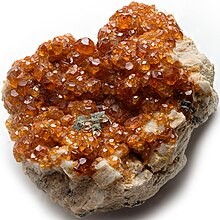
Garnet var. Spessartine, Putian City, Putian Prefecture, Fujian Province, China
Largest garnet crystal
The open-pit Barton Garnet Mine, located at Gore Mountain in the Adirondack Mountains, yields the world's largest single crystals of garnet; diameters range from 5 to 35 cm and commonly average 10–18 cm.
Gore Mountain garnets are unique in many respects, and considerable effort has been made to determine the timing of garnet growth. The first dating was that of Basu et al. (1989), who used plagioclase-hornblende-garnet to produce a Sm/Nd isochron that yielded an age of 1059 ± 19 Ma. Mezger et al. (1992) conducted their own Sm/Nd investigation using hornblende and the drilled core of a 50 cm garnet to produce an isochron age of 1051 ± 4 Ma. Connelly (2006) utilized seven different fractions of a Gore Mountain garnet to obtain a Lu-Hf isochron age of 1046.6 ± 6 Ma. It is therefore concluded with confidence that the garnets formed at 1049 ± 5 Ma, the average of the three determinations. This is also the local age of peak metamorphism in the 1090–1040 Ma Ottawan phase of the Grenvillian orogeny and serves as a critical data point in ascertaining the evolution of the megacrystic garnet deposits.
The open-pit Barton Garnet Mine, located at Gore Mountain in the Adirondack Mountains, yields the world's largest single crystals of garnet; diameters range from 5 to 35 cm and commonly average 10–18 cm.
Gore Mountain garnets are unique in many respects, and considerable effort has been made to determine the timing of garnet growth. The first dating was that of Basu et al. (1989), who used plagioclase-hornblende-garnet to produce a Sm/Nd isochron that yielded an age of 1059 ± 19 Ma. Mezger et al. (1992) conducted their own Sm/Nd investigation using hornblende and the drilled core of a 50 cm garnet to produce an isochron age of 1051 ± 4 Ma. Connelly (2006) utilized seven different fractions of a Gore Mountain garnet to obtain a Lu-Hf isochron age of 1046.6 ± 6 Ma. It is therefore concluded with confidence that the garnets formed at 1049 ± 5 Ma, the average of the three determinations. This is also the local age of peak metamorphism in the 1090–1040 Ma Ottawan phase of the Grenvillian orogeny and serves as a critical data point in ascertaining the evolution of the megacrystic garnet deposits.
Red garnets were the most commonly used gemstones in the Late Antique Roman world, and the Migration Period art of the "barbarian" peoples who took over the territory of the Western Roman Empire. They were especially used inlaid in gold cells in the cloisonné technique, a style often just called garnet cloisonné, found from Anglo-Saxon England, as at Sutton Hoo, to the Black Sea. Thousands of Tamraparniyan gold, silver and red garnet shipments were made in the old world, including to Rome, Greece, the Middle East, Serica and Anglo Saxons; recent findings such as the Staffordshire Hoard and the pendant of the Winfarthing Woman skeleton of Norfolk confirm an established gem trade route with South India and Tamraparni (ancient Sri Lanka), known from antiquity for its production of gemstones.
Pure crystals of garnet are still used as gemstones. The gemstone varieties occur in shades of green, red, yellow, and orange. In the United States it is known as the birthstone for January. It is also the birthstone of Aquarius and Capricorn in tropical astrology. The garnet family is one of the most complex in the gem world. It is not a single species, but is composed of multiple species and varieties.
Almandine garnet is the state mineral of Connecticut, star garnet is the state gemstone of Idaho, garnet is the state gemstone of New York, and grossular garnet is the state gemstone of Vermont.
Pure crystals of garnet are still used as gemstones. The gemstone varieties occur in shades of green, red, yellow, and orange. In the United States it is known as the birthstone for January. It is also the birthstone of Aquarius and Capricorn in tropical astrology. The garnet family is one of the most complex in the gem world. It is not a single species, but is composed of multiple species and varieties.
Almandine garnet is the state mineral of Connecticut, star garnet is the state gemstone of Idaho, garnet is the state gemstone of New York, and grossular garnet is the state gemstone of Vermont.
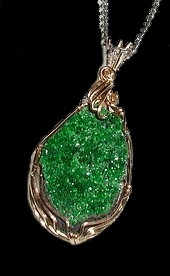
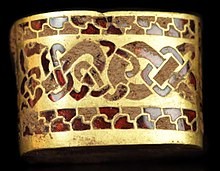
c. 7th century AD, Anglo-Saxon seax hilt fitting – gold with gemstone inlay of garnet cloisonné. From the Staffordshire Hoard, found in 2009, and not fully cleaned
Pendant in uvarovite, a rare bright-green
garnet
garnet


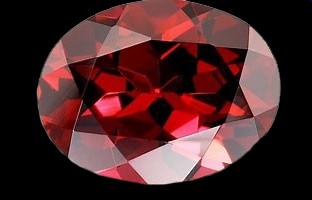
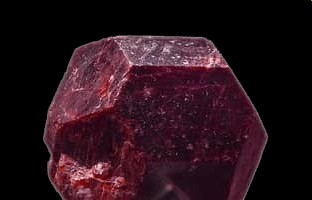
[4]
[3]
[2]
[1]






















